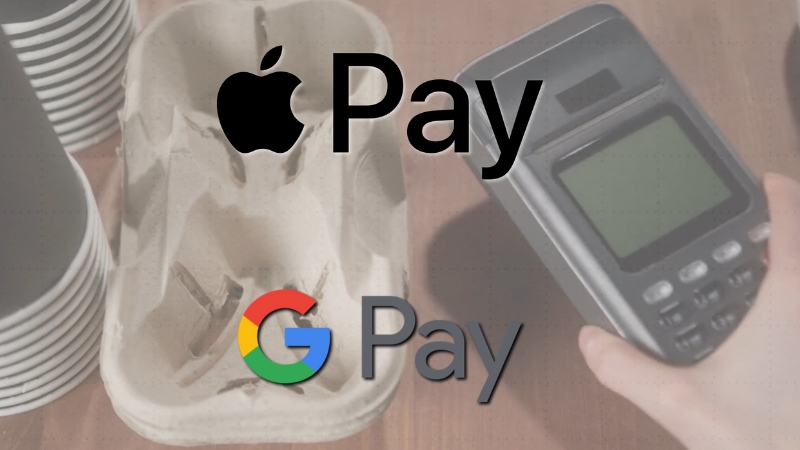When Americans reach for their phones at checkout, the choice often comes down to Apple Pay or Google Pay. By 2025, the contest is no longer close: Apple Pay dominates the U.S. market.
According to Insider Intelligence and Capital One Shopping’s 2025 estimates, Apple Pay has around 65.6 million active U.S. users, while Google Pay (now integrated into Google Wallet) trails with about 35 million.
In terms of market share, Apple accounts for nearly half of all U.S. mobile wallet users (49.0%), compared to Google’s 30.1%. And when it comes to actual in-store mobile wallet transactions, Apple captures a majority share – roughly 54% of all mobile wallet taps in 2024 carried the Apple Pay logo.
Put simply, Apple Pay has become the default mobile payment method for most Americans, thanks to the iPhone’s dominance, broad retailer acceptance, and user familiarity. Google Pay, while strong among Android users, remains a secondary player in the U.S.
Why Apple Pay Leads in 2025

The biggest driver of Apple Pay’s advantage is the iPhone itself. In the U.S., Apple devices account for nearly 59% of the smartphone market (as of late 2024), giving Apple Pay a massive built-in audience.
Nearly every new iPhone comes with Apple Wallet preinstalled, which makes adoption almost automatic. According to Apple, its payment system is now accepted at 85–90% of U.S. merchants, making it as convenient as pulling out a plastic card.
Google Pay, in contrast, depends on a fragmented Android ecosystem. Acceptance is broadly similar (any NFC-enabled terminal can take it), but consumer adoption is weaker. CFPB data shows that U.S. Google Pay users grew from about 25 million in 2021 to a projected 35 million in 2025, a healthy rise but still far below Apple Pay’s scale.
The gap is partly because Android phones are split among many manufacturers, and Google Wallet does not always come preloaded or activated by default.
Usage Context: Mobile Wallets Still a Minority at Checkout
It’s important to note that while Apple Pay leads the field, mobile wallets overall remain a small fraction of U.S. checkout activity. The 2024 Pulse Debit Issuer Study reported that only 7% of debit point-of-sale purchases came from mobile devices.
At contactless-enabled terminals, phones and wearables made up 15% of in-store taps. Meanwhile, about 38% of U.S. debit cards are now loaded into mobile wallets, showing room for growth but also highlighting that most consumers still use physical cards.
This context matters: Apple Pay’s dominance is clear, but it is dominance over a payment method that is growing but not yet mainstream. As more retailers upgrade terminals and as younger consumers lean toward mobile-first payments, the share of mobile wallet transactions is expected to climb steadily.
Market Share and User Statistics: 2025 Snapshot
Metric (US, 2025)
Apple Pay
Google Pay (Google Wallet)
Notes
Active Users
~65.6M
~35M
Apple: Insider Intelligence / Capital One Shopping (2025). Google: CFPB projection.
Share of Mobile Wallet Users
49.0% (2024)
30.1% (2024)
Insider Intelligence split.
In-Store Wallet Transactions
~54% (2024)
Remaining share split
Apple Pay leads transaction volume.
Retailer Acceptance
85–90% of merchants
Similar NFC reach
Apple cites near-universal coverage, though Walmart is still a holdout.
Phone-Originated Debit Spend
7% of POS
7% of POS (combined category)
Mobile wallets are still a minority overall.
The Holdouts and Limits
Even though Apple Pay is accepted at 85–90% of U.S. merchants, according to Apple, it is not yet universal. The most prominent holdout is Walmart, the nation’s largest retailer with over 4,600 stores across the country.
Walmart continues to block Apple Pay, preferring to promote its proprietary Walmart Pay system, which runs through the Walmart app and uses QR code scanning rather than NFC.
This exclusion is significant, given Walmart’s scale: the company handles more than $600 billion in annual U.S. sales, which means that a huge portion of daily consumer transactions remain outside Apple Pay’s reach.
Other retail groups like Kroger and The Home Depot have also been inconsistent in supporting Apple Pay. While some Kroger-owned chains, such as Ralphs and King Soopers, accept it, many locations of Kroger proper still do not.
Similarly, Home Depot initially rolled out support but later pulled back, citing system compatibility issues. These gaps remind us that merchant adoption, even a decade after Apple Pay’s 2014 launch, is still uneven across sectors.
Smaller merchants also face hurdles. While modern payment terminals support NFC by default, many independent retailers are slow to upgrade because of cost concerns. According to the Federal Reserve’s 2024 Payments Study, around 20% of U.S. small businesses still rely on older, non-NFC card readers.

For Apple Pay and Google Pay, this means that a long tail of merchants – coffee shops, salons, rural stores – remains card-only.
For Google Pay, the challenge is not so much acceptance as it is adoption by Android users. Even when Google Wallet is available at checkout, many U.S. Android owners default to swiping a plastic card. Part of this comes down to habits: Americans have decades of card-centric behavior.
But another factor is ecosystem integration. Apple Pay ties neatly into the Apple Watch, Safari checkout, iCloud Keychain, and even MacBooks, reinforcing its use across multiple touchpoints. Google Wallet, despite recent upgrades, does not have the same seamless lock-in for Android users in the U.S.
Data backs up this lag. According to a 2024 PYMNTS survey, 52% of U.S. iPhone users with Apple Pay enabled used it regularly at checkout, compared to only 22% of Android users with Google Pay. That means even within each base, Apple users are more engaged than their Android counterparts, which compounds the market share gap.
The Future of Mobile Payments in the U.S.

The competition between Apple and Google is no longer just about replacing the credit card – it’s about redefining what a wallet is. Both companies are pushing hard to transform their apps into all-in-one identity and commerce platforms.
- Apple Pay / Apple Wallet: Already supports driver’s licenses and state IDs in select U.S. states (Arizona, Maryland, Colorado, Georgia), with expansion planned. Apple has also built partnerships with airlines, universities, and transit agencies – allowing students to use their iPhone as a campus card or commuters to tap into subways with Apple Wallet. Integration with car manufacturers (like BMW and Hyundai) even allows drivers to store digital car keys in Wallet.
- Google Wallet: Rebuilt from the old Google Pay framework, Google Wallet in 2025 also supports boarding passes, vaccination records, student IDs, and transit cards. Google is pushing integrations globally, especially in regions like Europe and Asia, where Android dominates. However, in the U.S., adoption of these “beyond payments” features has lagged behind Apple, largely because the Android ecosystem is fragmented and OEMs often preinstall competing wallets such as Samsung Wallet.
Looking ahead, the biggest growth lever is generational. Surveys from Morning Consult show that Gen Z and Millennials are twice as likely as Baby Boomers to use mobile wallets.
Among Gen Z, more than 50% report using Apple Pay or Google Pay weekly, compared to fewer than 15% of Boomers. This suggests that as younger consumers gain spending power, mobile payments will naturally expand their footprint.
Still, the central question is whether either Apple Pay or Google Pay can truly displace physical cards. As of 2024, mobile wallets account for just 7% of debit POS transactions and 15% of in-store contactless taps, according to the Pulse Debit Issuer Study. That leaves an overwhelming majority of payments still running through plastic.
For Apple, the path forward looks promising: its 65.6 million U.S. users in 2025 represent nearly double Google’s 35 million, and Apple controls almost half the mobile wallet user base (49.0%). Unless Android’s U.S. market share expands significantly, Apple Pay’s lead will only widen.
Google Pay remains respectable, especially for global Android adoption, but in the U.S., it is unlikely to surpass Apple in the near term.
The more compelling race may not be Apple vs Google, but wallets vs plastic. If U.S. regulators push digital ID adoption, if retailers incentivize mobile payments, and if banks continue to promote tokenized card security, the next five years could finally tip consumer behavior.
Until then, both Apple and Google will continue to fight for wallet dominance in a market that still overwhelmingly prefers swiping a card.
In fact, one of the fastest-growing areas is the overlap between mobile wallets and crypto payments. While neither Apple Pay nor Google Pay currently allows direct Bitcoin spending in the U.S., many users now buy and store crypto through exchange apps and then move funds just as easily as tapping a card.
That same infrastructure is spilling into sectors like entertainment and sports wagering, where digital wallets and crypto are merging to create faster and more private payment flows. For a clear example of how this is evolving, you can check this out and see more for yourself.
Bottom Line
@naseros.com Apple Pay vs Google Pay #applepay #googlepay #pagos #seguridad #pagosseguros #pagoseguro🔐💳💰 #pagoseguro ♬ sonido original – NASeros – NASeros 🛜 🌐
According to industry forecasts, Apple Pay sits at 65.6 million U.S. users in 2025, almost double Google Pay’s 35 million. Apple controls nearly half the mobile wallet user base (49.0%), dominates in-store wallet taps at 54%, and boasts 85–90% retailer acceptance. Google Pay, while strong globally, holds a much smaller slice of the American market.
Still, mobile wallets overall remain underused compared to plastic cards, with only 7% of debit purchases coming from phones. This means that while Apple Pay has clearly won the head-to-head with Google Pay in 2025, both still have work to do in convincing Americans to ditch the card altogether.
Related Posts:
- Latest Job Market Trends: Why 20% of U.S. Companies…
- Smart Home Safety Market Reached Over 34 Billion…
- RPM by the Numbers - Market Growth, Adoption Rates,…
- Antibiotics Market Estimated To Reach US$ 58.4…
- Global Healthcare Simulation Market Projected to Hit…
- Market Analysts Forecast $26 Billion Orthodontic…








